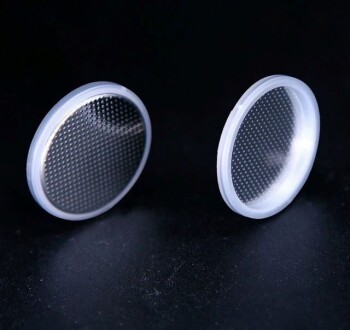For a consumer, the only definitive way to identify a CVD diamond is to review its official grading report from a reputable gemological laboratory like the GIA or IGI. Professionals require highly specialized equipment to detect the microscopic indicators of lab growth, as CVD diamonds are chemically, physically, and optically identical to their natural counterparts.
The core issue is that a CVD diamond is not a "fake" but a real diamond with a different origin. Because it shares the same properties as a natural stone, identification is impossible with the naked eye and requires professional, scientific verification.

Why Visual Inspection Isn't Enough
Many assume there must be a simple visual trick to distinguish a lab-grown diamond from a natural one. This assumption is incorrect and stems from a misunderstanding of what a CVD diamond truly is.
Identical Chemical and Physical Makeup
A CVD (Chemical Vapor Deposition) diamond is structurally a real diamond. It has the same carbon atom lattice, making it physically and chemically identical to a diamond mined from the earth.
This means it exhibits the same hardness, brilliance, and fire. To the eye, a jeweler's loupe, or a basic diamond tester, it is indistinguishable.
Growth Signatures Are Microscopic
The differences between natural and lab-grown diamonds exist at an atomic level. They relate to the specific conditions under which the diamond formed.
Laboratories can detect trace elements or specific crystal growth patterns that act as signatures of the CVD process. These markers are invisible without advanced spectroscopic equipment.
The Definitive Methods for Identification
Because visual inspection is unreliable, identification relies on documentation and advanced gemological testing. These are the only trusted methods.
1. The Grading Certificate
This is the most critical tool for any buyer. Reputable labs issue a detailed report for every graded diamond.
On the certificate, check the "Origin" section. The comments will explicitly state if it is "Laboratory-Grown" or mention "CVD" or "as-grown."
2. The Laser Inscription
Most diamonds graded by labs like GIA or IGI have a microscopic laser inscription on their girdle (the thin outer edge).
This inscription contains the report number and often will state that the diamond is lab-grown. A jeweler can read this inscription for you with a high-powered magnifier.
3. Advanced Laboratory Analysis
Gemological laboratories use sophisticated equipment to make a definitive origin determination.
Specialized machines look for minute trace elements, such as silicon, that can be incorporated during the CVD growth process but are not found in natural diamonds. They also analyze strain patterns under magnification, which differ between lab-grown and natural stones.
Common Pitfalls to Avoid
Understanding the nature of CVD diamonds helps you avoid common misconceptions and potential pitfalls when purchasing or appraising a stone.
Mistaking "Real" for "Natural"
A CVD diamond is a real diamond; it is simply not a natural one. It is not a simulant like cubic zirconia or moissanite, which have completely different chemical compositions and properties.
Relying on a Jeweler's Loupe
Do not trust anyone who claims they can identify a CVD diamond with a simple jeweler's loupe. While a loupe is essential for assessing a diamond's clarity and cut, it cannot reveal its origin.
The Critical Importance of Disclosure
Reputable sellers will always disclose a diamond's origin upfront. A lack of transparency or an unwillingness to provide a grading report is a significant red flag. The certificate is your primary source of verification.
Making the Right Choice for Your Goal
Your approach to verification depends entirely on your role and your objective.
- If your primary focus is buying a diamond: Always demand an independent grading certificate from a major lab (like GIA or IGI) and verify the report number on their website.
- If your primary focus is identifying an existing, uncertified stone: You must submit it to a professional gemological laboratory for testing, as this is the only way to get a conclusive answer.
- If your primary focus is professional appraisal: You must rely on specialized screening instruments designed to detect the markers of lab-grown diamonds, not on traditional gemological tools alone.
Ultimately, confident identification is a matter of relying on scientific evidence, not subjective visual assessment.
Summary Table:
| Method | Description | Key Takeaway |
|---|---|---|
| Grading Certificate | Official report from labs like GIA/IGI. | Check the 'Origin' section for 'Laboratory-Grown' or 'CVD'. |
| Laser Inscription | Microscopic number/note on the diamond's girdle. | A jeweler can verify the report number and lab-grown status. |
| Lab Analysis | Advanced spectroscopic equipment used by professionals. | Detects microscopic growth signatures and trace elements like silicon. |
Need precise, reliable equipment for material analysis?
The process of identifying a CVD diamond underscores the critical need for advanced, accurate laboratory technology. At KINTEK, we specialize in supplying high-quality lab equipment and consumables that empower professionals with the precision and reliability required for such detailed verification tasks.
Whether you are a gemological lab, a research institution, or an industrial facility, our products are designed to meet the rigorous demands of modern science. Contact us today to discuss how our solutions can enhance the accuracy and efficiency of your analytical processes.
Get in touch with our experts now!
Visual Guide

Related Products
- HFCVD Machine System Equipment for Drawing Die Nano-Diamond Coating
- Laboratory CVD Boron Doped Diamond Materials
- 915MHz MPCVD Diamond Machine Microwave Plasma Chemical Vapor Deposition System Reactor
- CVD Diamond Cutting Tool Blanks for Precision Machining
- CVD Diamond Domes for Industrial and Scientific Applications
People Also Ask
- What is microwave plasma CVD? A Guide to High-Purity Diamond and Material Synthesis
- What machine is used to make lab-grown diamonds? Discover the HPHT & CVD Technologies
- How do CVD diamonds grow? A Step-by-Step Guide to Lab-Grown Diamond Creation
- Is sputtering a PVD? Discover the Key Coating Technology for Your Lab
- What is the hot filament chemical vapour deposition of diamond? A Guide to Synthetic Diamond Coating


















